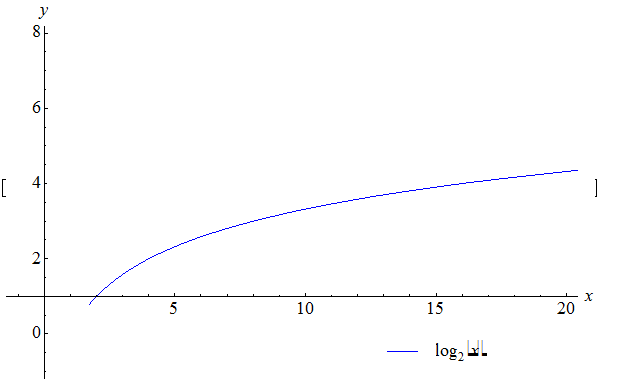
a.
How is the logarithmic function
a.
Answer to Problem 4RCC
Explanation of Solution
Given information:
How is the logarithmic function
Calculation:
The inverse of an exponential function is called the logarithm function. We defined the logarithm function
Hence, the solution is
b.
What is the domain of this function
b.
Answer to Problem 4RCC
Explanation of Solution
Given information:
What is the domain of this function
Calculation:
The inverse of an exponential function is called the logarithm function. We can determine its domain by looking at the range of the exponential function, range of any exponent is the interval:
Thus, conclusion is domain
Hence, the solution is
c.
What is the range of this function
c.
Answer to Problem 4RCC
All real numbers
Explanation of Solution
Given information:
What is the range of this function
Calculation:
The inverse of an exponential function is called the logarithm function. The range of logarithm function will be equal to domain of logarithm function.
Since the domain of logarithm function is all real numbers.
Hence, the solution is all real numbers
d.
Sketch the general shape of the graph of the function.
d.
Answer to Problem 4RCC
The solution is shown in graph.
Explanation of Solution
Given information:
Sketch the general shape of the graph of the function
Calculation:
The graph of function
 .
.
Hence, the solution is shown in graph.
e.
What is the natural logarithm?
e.
Answer to Problem 4RCC
Logarithm function with base
Explanation of Solution
Given information:
What is the natural logarithm?
Calculation:
Take any positive number that is not equal to
So, of logarithm function with base
Hence, the solution is Logarithm function with base
f.
What is the common logarithm?
f.
Answer to Problem 4RCC
Logarithm function with base
Explanation of Solution
Given information:
What is the common logarithm?
Calculation:
Take any positive number that is not equal to
So, of logarithm function with base
The common logarithm is denoted by leaving off the base as it is assumed to be
Hence, the solution is Logarithm function with base
Chapter 4 Solutions
Precalculus: Mathematics for Calculus - 6th Edition
- For each graph in Figure 16, determine whether f (1) is larger or smaller than the slope of the secant line between x = 1 and x = 1 + h for h > 0. Explain your reasoningarrow_forwardPoints z1 and z2 are shown on the graph.z1 is at (4 real,6 imaginary), z2 is at (-5 real, 2 imaginary)Part A: Identify the points in standard form and find the distance between them.Part B: Give the complex conjugate of z2 and explain how to find it geometrically.Part C: Find z2 − z1 geometrically and explain your steps.arrow_forwardA polar curve is represented by the equation r1 = 7 + 4cos θ.Part A: What type of limaçon is this curve? Justify your answer using the constants in the equation.Part B: Is the curve symmetrical to the polar axis or the line θ = pi/2 Justify your answer algebraically.Part C: What are the two main differences between the graphs of r1 = 7 + 4cos θ and r2 = 4 + 4cos θ?arrow_forward
- A curve, described by x2 + y2 + 8x = 0, has a point A at (−4, 4) on the curve.Part A: What are the polar coordinates of A? Give an exact answer.Part B: What is the polar form of the equation? What type of polar curve is this?Part C: What is the directed distance when Ø = 5pi/6 Give an exact answer.arrow_forwardNew folder 10. Find the area enclosed by the loop of the curve (1- t², t-t³)arrow_forward1. Graph and find the corresponding Cartesian equation for: t X== y = t +1 2 te(-∞, ∞) 42,369 I APR 27 F5 3 MacBook Air stv A Aa T 4 DIIarrow_forward
- Middle School GP... Echo home (1) Addition and su... Google Docs Netflix Netflix New folder 9. Find the area enclosed by x = sin²t, y = cost and the y-axis.arrow_forward2. Graph and find the corresponding Cartesian equation for: (4 cos 0,9 sin 0) θ ε [0, 2π) 42,369 I APR 27 3 MacBook Air 2 tv A Aaarrow_forward30 Page< 3. Find the equation of the tangent line for x = 1+12, y = 1-3 at t = 2 42,369 APR A 27 M . tv NA 1 TAGN 2 Aa 7 MacBook Air #8arrow_forward
 Calculus: Early TranscendentalsCalculusISBN:9781285741550Author:James StewartPublisher:Cengage Learning
Calculus: Early TranscendentalsCalculusISBN:9781285741550Author:James StewartPublisher:Cengage Learning Thomas' Calculus (14th Edition)CalculusISBN:9780134438986Author:Joel R. Hass, Christopher E. Heil, Maurice D. WeirPublisher:PEARSON
Thomas' Calculus (14th Edition)CalculusISBN:9780134438986Author:Joel R. Hass, Christopher E. Heil, Maurice D. WeirPublisher:PEARSON Calculus: Early Transcendentals (3rd Edition)CalculusISBN:9780134763644Author:William L. Briggs, Lyle Cochran, Bernard Gillett, Eric SchulzPublisher:PEARSON
Calculus: Early Transcendentals (3rd Edition)CalculusISBN:9780134763644Author:William L. Briggs, Lyle Cochran, Bernard Gillett, Eric SchulzPublisher:PEARSON Calculus: Early TranscendentalsCalculusISBN:9781319050740Author:Jon Rogawski, Colin Adams, Robert FranzosaPublisher:W. H. Freeman
Calculus: Early TranscendentalsCalculusISBN:9781319050740Author:Jon Rogawski, Colin Adams, Robert FranzosaPublisher:W. H. Freeman
 Calculus: Early Transcendental FunctionsCalculusISBN:9781337552516Author:Ron Larson, Bruce H. EdwardsPublisher:Cengage Learning
Calculus: Early Transcendental FunctionsCalculusISBN:9781337552516Author:Ron Larson, Bruce H. EdwardsPublisher:Cengage Learning





